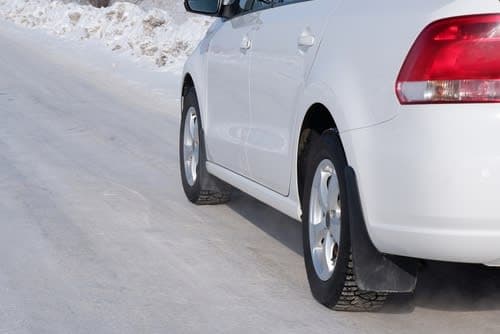Tire Maintenance & Safety
Essential Winter Tire Safety Tips for Better Traction & Control

Free shipping
Best price guarantee
Special pricing
Financing with Resolve
Easy returns
Tire Maintenance & Safety

Winter weather transforms roads into unpredictable surfaces that challenge even the most experienced drivers. Snow, ice, and freezing temperatures create hazardous conditions that require specialized equipment and careful preparation to navigate safely.
Your tires serve as the only connection between your vehicle and the pavement — a critical relationship that becomes even more important when temperatures drop below 45°F. Standard all-season tires lose flexibility and traction in cold weather, making winter-specific tires essential for maintaining control and safety during the coldest months.
The difference between arriving safely at your destination and experiencing a weather-related incident often comes down to proper tire selection and maintenance. Understanding how winter tires work and implementing key safety practices can dramatically improve your vehicle's performance when Mother Nature delivers her worst.
Winter tires represent a significant advancement in cold-weather driving technology, engineered specifically to excel when temperatures consistently drop below 45°F (7°C). Unlike all-season tires that compromise performance across various conditions, winter tires focus exclusively on delivering superior traction, handling, and safety in snow, ice, and cold temperatures.
The magic lies in their specialized rubber compounds: winter tires use a unique silica-based formula that remains soft and pliable even in freezing conditions. This flexibility allows the tire to conform to road irregularities and maintain grip where standard tires would become rigid and lose contact. The Three-Peak Mountain Snowflake symbol on the sidewall identifies tires that meet specific snow traction performance requirements — a certification that goes beyond the basic M+S (mud and snow) designation found on many all-season tires.

Choosing the right winter tires improves your vehicle's stability on icy roads. Proper tire selection and diligent upkeep are crucial to maximizing the advantages of winter tires.
Cold weather can lead to lower tire pressure — maintaining the correct pressure ensures your tires perform at their best. Insufficient tire inflation affects grip and accelerates wear, which can result in uneven performance and decreased safety. Use a reliable tire gauge to inspect pressure monthly, ensuring it matches the manufacturer’s recommendations. Cold temperatures can reduce tire pressure by roughly 1 PSI for every 10°F drop, making consistent checks essential during chilly months.
Having sufficient tread depth is vital for winter tire safety to maintain proper traction on slick roads. Use a tread depth gauge to routinely inspect your tires, replacing them if the tread falls to 4/32 of an inch or less. Most winter tires come with a tread depth of 10/32 to 12/32 of an inch, offering enough depth to grip snow and slush effectively. Deep grooves and sipes are essential for channeling away water and slush, preventing hydroplaning and boosting overall safety.
Timing is important for maximizing the performance of winter tires. Aim to fit winter tires before the first snowfall to ensure preparedness for unexpected weather changes. Early installation also allows the tires to adjust to cooler conditions, enhancing their effectiveness when winter arrives. By having winter tires ready, you minimize the risk of being unprepared for sudden snow or ice, which can affect driving safety.
Regular tire rotation helps to achieve even wear, extending the lifespan of your winter tires. Follow the manufacturer’s guidelines for rotation intervals—usually every 5,000 to 8,000 miles. Proper rotation maintains balanced traction across all tires, ensuring that each tire wears evenly and functions optimally throughout the season. This not only increases tire longevity but also maintains consistent handling and control.
Adjusting your driving habits to suit winter conditions is essential. Slow down and leave more space between your vehicle and others to account for reduced traction on icy or snowy roads. Always stay vigilant for potential hazards like black ice, which can be nearly invisible yet extremely dangerous. By driving carefully, you protect yourself and ensure the safety of others on the road.

As winter gives way to warmer months, storing your winter tires correctly is vital for their longevity. Choose a location that maintains a consistent, cool temperature and shields them from humidity. Avoid areas with direct sunlight or heat, as these can cause the rubber to deteriorate prematurely. It’s beneficial to either stack the tires horizontally or use tire racks to preserve their shape. Protective covers or bags can guard against dust and moisture, ensuring the rubber remains intact.
Conducting regular checks on your tires allows you to identify potential issues early. Inspect the sidewalls for any signs of damage, such as tears or swelling, which could indicate a compromised tire. Keep an eye out for uneven tread wear, as this might suggest a need for rotation or alignment adjustments. Check for any lodged debris, like pebbles or shards, that could lead to punctures. Addressing these concerns promptly helps maintain tire performance and safety.
Professional expertise plays a crucial role in maintaining tire safety and effectiveness. An expert can provide a thorough assessment of your tire's condition, identifying subtle issues that might go unnoticed. They offer services like precise balancing and alignment checks to ensure your tires wear evenly and handle well. When uncertain about your tire's state or when needing specialized maintenance, seeking professional help guarantees your tires remain in top shape for the next winter.
Winter tire safety ultimately comes down to choosing the right tires and maintaining them properly throughout the season. By following these essential tips, you'll maximize your vehicle's performance and protect yourself and your passengers when road conditions turn treacherous. Ready to upgrade your winter driving safety? Shop for tires online and find the best deals — we make it easy to find the perfect winter tires for your vehicle and driving needs.
Search By